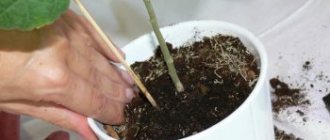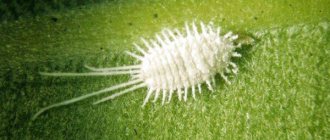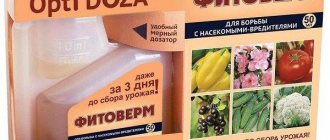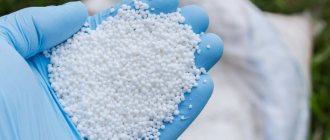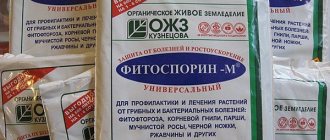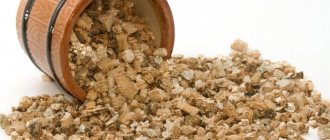How to dilute aktar for watering indoor plants?
Today, not a single owner of indoor plants is immune from the invasion of dangerous insects - pests that can destroy a flower and cause harm to its root system. If you act on time and take the right actions, you can protect the plant and preserve its beauty. One of the most practical and high-quality drugs that affects the condition of the flower is Aktara. How to dilute Aktara for watering indoor plants? We will learn the answer to this question from this article.
How to breed Aktara?
Does the drug help?
Neonicotinoids act on the mealybug's nicotinic acetylcholine receptor, suppressing the feeding reflex.
Traces of mealybug activity on plants.
While eating, healthy insects are almost motionless on the leaf. After taking thiamethoxam, the sucking insect stops feeding, and even if death does not occur immediately, the effect is comparable to a knockdown, since the cessation of feeding is irreversible.
Aktara for indoor plants - instructions for use
Aktara is a systemic drug, an insecticide, which was created to combat the most common pests of flowers: thyroid gland, aphids, whiteflies, spider mites, thrips and mealyworms. After treatment with the drug, the plant becomes protected and is completely cleared of pests, which die within 24 hours. But in order to benefit from using the drug, it is important to learn how to use it and strictly follow the instructions given.
Aktara is a fine powder in the form of small grains. It is very easy to use for preparing a special solution or for treating soil. The first signs of insect death can be noticed within 30 minutes. Where can you buy Aktara? The drug is sold in all specialized stores and has different packaging - from 4 g to 250 g. If you want to treat indoor plants, then a 1 g package is ideal for you.
When is the best time to use Aktara? The product is universal, so it can be used all year round, regardless of the air temperature or the influence of sunlight. Aktara is not washed off with water, so indoor plants can continue to be watered as usual. The drug also comes into good contact with other insecticides, so don’t be afraid to mix them.
Advantages of using the drug Aktara:
- Rapid penetration into the leaves of the plant, its shoots and root system. Pests begin to be destroyed almost immediately after applying the drug.
- High efficiency indicators when spraying a flower or adding the drug to the soil.
- A simple recipe for preparing the solution and the product dissolves quickly.
- Long-term protection of plants from the negative influence of several insects at once.
- Economical consumption and minimal number of treatments.
- Long-lasting effect even after a single application.
- High activity at low, high temperatures, scorching sun or high humidity.
Important! With frequent use of Aktara, some pests become accustomed to it, so they may no longer react to its presence.
Folk remedies
If berry crops are slightly affected by mealybugs, then to get rid of the pest it is recommended to use folk remedies that are less toxic than pesticides. For example:
- Oil . A couple of liters of water are mixed with 2 tbsp. l. olive oil. The resulting product is applied to the bushes using a spray bottle.
- Horsetail tincture . This drug can be purchased at a pharmacy and is used to purify the blood and as a diuretic. To treat the bush, use a cotton swab, which is moistened in the tincture.
- Soap solution with alcohol . 10 milligrams of denatured alcohol and 1 gram of liquid soap are dissolved in one liter of water.
- Garlic infusion . Half a liter of boiling water is combined with four or five garlic cloves, which are pre-chopped. The infusion will be ready after 4-5 hours; it is only filtered and processing begins immediately after that.
- Garlic tincture . Seventy percent alcohol is combined with chopped garlic in a 3:1 ratio. The treatment is carried out using a cotton swab.
- Citrus infusion . Add 50 grams of citrus peels (tangerine, orange or lemon) to 1 liter of warm water. The infusion will be ready after 24 hours; immediately after it has been filtered, begin spraying the bushes.
- Calendula infusion . One liter of water is combined with 100 grams of dried calendula flowers. After 24 hours, the infusion is filtered, and then it is used to wipe the affected areas.
- Hot water . First, the bush affected by scale insects is pulled out of the container, then its root system should be cleaned of the substrate, which may contain pests. Then the entire bush is immersed in warm water (from 45 to 55 degrees) for a quarter of an hour. Next, the plant is thoroughly dried and planted in a new disinfected soil mixture.
But remember that folk remedies will be effective only if there are very few pests, either at the initial stage of infection, or for preventive purposes. If there are already a lot of pests on the plant, then the bush should be immediately treated with a systemic insecticidal preparation, since folk remedies will be ineffective and by using them, you can lose precious time.
How to use Aktar for indoor plants?
So, if you bought the drug, you need to mix it correctly, while observing the established proportions. Preparation of the solution begins with heating the water, the temperature of which should be no lower than +25 degrees. It is in this water that all the granules of the product will dissolve. For 5 liters of water you will need 4 g of Aktara. If this volume is too large for you, then create a proportion and use the amount of the drug that suits you.
Immediately after treating the plant, be sure to ventilate the room, since the product quickly spreads through the air. What to do if it is not possible to spray the room? In this case, it is recommended to pour the drug directly into the ground. Then, through the roots, the product spreads throughout the flower and reaches its very top leaves, killing all pests in its path. Is Aktara safe for the plant itself? Undoubtedly. It will not harm your flower, so you don’t have to worry about its safety.
Also always follow safety rules when spraying plants. Wear gloves to protect the delicate skin of your hands and gauze bandages to prevent particles of the drug from entering the respiratory tract. If Aktara accidentally gets on your skin, immediately rinse it off under strong water pressure, and then lubricate it with a light, moisturizing cream. Always hide the drug if there are children in the house.
So, now you know how to dilute actara for watering indoor plants. We hope that our tips will help you protect your indoor flowers from the negative influence of insects, so that you can continue to enjoy the beauty, greenery and flowering of your plants.
See also video: How to grow aktara for watering and spraying indoor plants
Aktara liquid
Liquid Aktara for the Colorado potato beetle is available in 9 ml bottles or 1.2 ml ampoules. This is a suspension with a concentration of the active substance thiamethoxam of 240 g/l.
Despite the fact that the Colorado potato beetle is depicted on the packaging and is mentioned in the title, liquid actara destroys all pests except mites: aphids, thrips, whiteflies, scale insects, scale insects, false scale insects, poduras, fungus gnats, codling moths, copperheads, etc. The consumption rates are as follows the same as actara in granules.
Since liquid actara is available in 1.2 ml packaging, it is easier to count using a syringe. For example, for currants, dilute the entire ampoule (1.2 ml) in 6 liters of water, for onion flies - 1.2 ml in 3 liters of water, and to cure roses from thrips with actara, you need to dilute 1.2 ml in 750 ml of water.
Description
The insecticide "Aktara" is a systemic drug that combines both intestinal and contact action. The product is produced in the form of granules, packaged in 4 g in foil vacuum bags.
Thanks to its systemic action , "Aktara" is used for indoor plants in the fight against such pests: scale insects, aphids, mealybugs, thrips, whiteflies and other insects. The only enemy that the drug cannot cope with is the tick.
Properties of the insecticide "Aktara":
- instant penetration into the shoots, leaves and roots of the plant;
- good solubility and odorlessness;
- efficiency both when spraying and when applied to the soil;
- long-term protection of the plant from several pests at the same time;
- low application rates and small number of treatments;
- long duration of residual action;
- activity at high temperatures, dry air and high humidity;
- resistance to bright sun.
The active ingredient "Aktar" thiamethoxam spreads throughout the plant after 20 hours. When treating a large plant, the drug reaches its top within 3 days.
The effect of Aktara on insects appears within 30-60 minutes. Their digestive system becomes paralyzed and they stop eating. Weak individuals die immediately, and complete destruction of insects occurs within 24 hours.
The time of residual protective effect of the drug when sprayed is 15 - 28 days, when applied to the soil - approximately 40 - 60 days.
An important point is that with repeated treatments, the drug can cause insects to become addicted to it. Therefore, it is recommended to alternate Aktara with other chemicals.
The drug is compatible with all fungicides and other insecticides, except for products that contain soap, lime and Bordeaux mixture.
Why are mealybugs dangerous?
Mealybugs are tiny, white insects, about 3mm. in length, but their color and habit of grouping make them easy to spot on garden plants. They belong to aphids. Many (if not all) houseplants are susceptible to infestation, including: gardenias, begonias, chrysanthemums, ficus trees, English ivy and palms.
Any plant that has high nitrogen levels due to overfertilization will be especially attractive to pests.
Mealybugs feed by sucking sap from leaves, stems, roots, flowers and fruits. Damaged leaves appear wrinkled. In addition, insects can infect plants with mesh egg sacs and clusters of larvae.
Compounding the damage, the insect contains black sooty mold and promotes the growth of plant viruses.
Instructions for use of the drug Aktara
The Aktara working solution should be prepared It is advisable to treat plants with a freshly prepared solution.
It is recommended to spray the composition at a distance of 25 to 30 cm from the affected plant.
Doses of the drug when treating indoor plants:
For spraying plants: 4 g of Aktara should be diluted in 5 liters of water. The resulting solution is enough for about 125 small plants.
For watering the soil . 1 g of Aktara should be diluted in 10 liters of water. The resulting quantity should be enough for 250 plants.
With a large number of pests. It is recommended to combine watering the soil with spraying the above-ground part of the plant.
Advantages and disadvantages
Before using Aktar against pests that pose a danger to orchids, you should carefully study the positive and negative characteristics of the insecticide. They are as follows.
- high efficiency against a wide range of dangerous insects;
- minimal phytotoxicity;
- resistance of the active component of the drug to elevated air temperatures;
- ensuring a long-term protective effect;
- ability to quickly penetrate plant tissues;
- efficiency and affordable price.
- it is likely that individual pests will become accustomed to the active substance and, as a result, a decrease in the effectiveness of the drug with long-term use (alternation with other drugs of similar action makes sense);
- low effectiveness against ticks;
- toxicity to humans and animals;
- when preparing working solutions in small volumes, it is necessary to very accurately measure the dose of the drug.
An important characteristic of the drug in relation to orchids is its resistance to washing off. Treated flowers can be bathed and sprayed within a few hours after treatment - this will not reduce the effectiveness of the insecticide.
Precautionary measures
"Aktara" belongs to moderately dangerous drugs ( third hazard class ) and requires special precautions:
- When working with the drug, you must use a respirator, safety glasses and rubber gloves.
- While processing plants, you should not eat, drink, or smoke.
- After completing the work, you need to ventilate the room well, wash your hands and face thoroughly, rinse your mouth and change clothes.
- The remaining solution along with the dishes should be disposed of by burning in a specially designated place.
- Do not throw the solution and the used container into bodies of water.
- The drug should be stored separately from food products, at a temperature from -15 ° C to +35 ° C and in a place inaccessible to children and animals.
Learn about the medicinal properties of alocasia, which it exhibits in home care.
Seek professional advice if it's time to replant your favorite anthurium while caring for it at home.
Hyacinths can be planted in the ground in the fall; read more here.
Fighting with chemicals
When the early stage is missed, and the invasion of harmful insects already threatens with disastrous consequences, then you have to fight using chemicals.
Affected indoor flowers and fruit and berry bushes need to be treated more than once at intervals of several days. The drugs that pests fear work in three directions:
- Systemic ones poison the juice without causing harm to the plant itself (Phosfamide, Rogor, Mospilan).
- Intestinal ones cause poisoning and digestive disorders (Aktellik, Akarin, Fitoverm, Nurell-D, Aktara).
- Contact ones act on the skin. Such drugs are used once (Spruzit-AESchadlingsfrei).
Let us pay special attention to the most effective chemical means of control. Aktara is a well-known complex drug
The solution must be thoroughly sprayed onto the plant and watered the soil to provide it with access to the root system. Aktara begins to fight hairy insects within half an hour and retains its effect for about a month. Suitable mainly for fruit plants. This product is very effective, but with frequent use it loses its properties, as pests become addicted. Aktara acts on the digestive system and reduces appetite
Aktara is a well-known complex drug. The solution must be thoroughly sprayed onto the plant and watered the soil to provide it with access to the root system. Aktara begins to fight hairy insects within half an hour and retains its effect for about a month. Suitable mainly for fruit plants. This product is very effective, but with frequent use it loses its properties, as pests become addicted. Aktara acts on the digestive system and reduces appetite.
It also has a poisonous effect. It does not harm the root system, since it consists of waste products of soil microorganisms and is completely dissolved in the soil. After just a few hours, the pests lose activity and soon die. Treatment with Fitoverm can be repeated after two weeks.
Aktara, Fitoverm, as well as Komandor and Zolotaya Iskra are considered the most aggressive and effective chemicals. With their help, you can fight even large colonies of mealybugs and those varieties that settle in the root system.
What to do if you are poisoned by Aktara?
Symptoms of drug poisoning : sweating, rapid breathing, decreased motor activity, convulsions. In case of poisoning, the following measures should be taken.
- First of all, it is necessary to ensure a flow of fresh air.
- If the product gets on your skin, wash it off with water and soap.
- If the drug gets into your eyes, rinse them thoroughly under running water.
- In case of accidental ingestion, drink 4 glasses of liquid and induce vomiting.
- Then you should take activated charcoal and consult a doctor immediately.
"Aktara" can become a faithful and reliable defender of a home flower greenhouse from attacks by voracious pests. The main thing is to use the drug correctly and not forget about precautions, and Aktara will take care of the safety of your green pets.
We also recommend that you familiarize yourself with the experience of an amateur gardener in protecting an orchid from mealybugs using Aktara.
News from partners:
2 comments
I will definitely try this product. And I know how to get rid of ants using a folk remedy that has been proven in practice. This is ordinary salt. Sprinkle salt on the areas where there are the most ants. And literally in a week you will forget about their existence.
I have been using this drug for quite some time. Aktara is a good preparation for treating potatoes against beetles and garden plants. The drug dissolves quickly in water and does not emit an unpleasant odor, so you can work without problems.
Pest prevention at home
The best remedy for mealybugs on houseplants is to regularly inspect your pets: especially carefully inspect the leaf axils, stem, and the inside and outside of the leaves.
At home, the pest is suppressed by ventilating the room, spraying and washing the leaves of plants, since the mealybug loves dry air and is afraid of moisture.
Avoid the situations described in the “Where Mealybugs Come From” section of the companion article.
ADDENDUM TO THE ARTICLE:
1. Mealybug - SIGNS OF DEFEAT, WHERE DOES IT COME FROM AND DESCRIPTION + PHOTO!
2. PESTS OF HOUSE PLANTS: PHOTO!
The review of the pest has come to an end. We hope that now you can fight mealybugs on indoor plants using drugs (insecticides) or folk remedies more effectively.
And the main thing is to be able to get rid of mealybugs and enjoy your favorite plants!
Systemic insecticide, also has an intestinal contact effect. Active ingredient: thiamethoxam, at a concentration of 250 g/kg and 240 g/l. Manufacturer: Syngenta Crop Protection AG, Switzerland. Available in the form of water-dispersible 1% granules, 25-35% suspension concentrate. Analogs and synonyms: Aktara, VDG; Aktara, KS; Doctor, TB; Adamant, gel; Cruiser, KS; Tiara, KS; Ephoria, KS, etc.
Used to protect garden crops and indoor plants from a wide range of pests (thrips, scale insects, scale insects, Colorado potato beetles, aphids, etc.), not effective against mites, ineffective against whiteflies!
Scale insect resistant to Aktara
#1 Natali
There are worms on the hoykas. She spilled it with Aktara, which was kept in a cache, but it didn’t help - after 4 days the worm, turned over on its belly, was happily shaking its legs.
I decided that Aktara was fake, bought a new one, and spilled it. Three days later, the bug is still alive, healthy and cheerful.
Today I wiped the stains with alcohol. But this is not a solution, because... There are probably some individuals already living on the neighboring hoyas that I didn’t notice.
Question: what else can you do to poison a mealybug without getting poisoned yourself?
By the way, this bug, like scale insects, secretes a sticky liquid. This is the first time I have encountered this.
#2 Nat
Natasha, what concentration of Aktara did you do?
#3 Tata
I have such a nasty bug on my figs.
#4 Natali
Natasha, what concentration of Aktara did you do?
About 2-3 times higher than in the instructions. Do you think we should pour a more concentrated one?
I have such a nasty bug on my figs.
Doesn’t he respond to Aktara either?
#5 [email protected]
I once struggled with a mealybug on a compact plant, first I washed it (to wash off the scaleworms and sticky coating) and diluted it according to the instructions, I lowered the entire plant with soil for 5-10 minutes, then on newspapers so that the moisture was absorbed from the soil and planted it in fresh substrate, but I had a hoyka in quarantine and didn’t have to wash all the plants and the window
I read in the Internet that sometimes Aktara is apparently of poor quality and there is no effect, but so far everything has been ok for me
I also infused tangerine and orange peels (folk remedy) in water and sprayed them with this solution as a preventive measure between treatments with Aktara
The bug is very harmful and can come out again in a year if not completely destroyed
Post edited [email protected]
(18.06.2013 – 12:40):
#6 Tata
Doesn’t he respond to Aktara either?
No. First I sprinkled the powder on the ground, hoping that it would work when watered.
I watered it with new Aktara, liquid, and spread it out a lot without measuring. Now we are waiting, sir.
#7 Natali
I read in the Internet that sometimes Aktara is apparently of poor quality and there is no effect
This is not my case, because... the false scale insect was killed once or twice by processing from the same Aktara package.
No. First I sprinkled the powder on the ground, hoping that it would work when watered.
I, too, back in the winter, when I first noticed the white reptiles, simply “salted” the soil (this method worked flawlessly for scale insects).
Could we not use such a low dosage (after all, Aktara does not completely dissolve in one watering) contribute to the development of resistance in the scale insect?
#8 Nat
It seems to me that Aktara is an easily soluble drug (not, for example, superphosphate, which takes a very long time to dissolve).
And even if Aktara is sprinkled and then watered, it should dissolve in moist soil within 24 hours. Or not?
I once had both a whitefly and a mealybug on a pomegranate. I watered the solution with 1 r. 2 times a week (2 times was for safety net).
The solution was made as follows: 0.5 l. a jar of water - soaked the end of a teaspoon in water and dipped it into a bag of Aktara. Whatever stuck, I dissolved in a jar of water. A lot stuck
#9 Natali
And even if Aktara is sprinkled and then watered, it should dissolve in moist soil within 24 hours. Or not?
For me it completely disappears only after a few waterings.
#10 Natali
I watered it with new Aktara, liquid, and spread it out a lot without measuring. Now we are waiting, sir.
Tanya, is there a result?
On Friday I diluted more than half a pack of dry Aktara per liter of water and watered it very generously. Today (three days after treatment) I picked the first mealybug I came across from the plant - alive and cheerful!
#11 Nat
Natasha, maybe I should try green soap? It is from all sucking and harmless
PS I fell in love with him this weekend. works flawlessly against flying aphids on tomatoes in open ground
#12 Tata
After liquid Aktara, I don’t seem to see any scale insects.
#13 Natali
Natasha, maybe I should try green soap?
I don’t want to bother with soap and other folk remedies. I would like something more effective so that I can treat it once and get rid of it forever.
For now I’m saving myself with alcohol wipes, but someone always goes unnoticed and after a week I find new, fresh masonry.
I want to spray it with Aktara tomorrow. Maybe at least the contact method will work?
After liquid Aktara, I don’t seem to see any scale insects.
Those. Did you leave a “control” on the plant?
#14 Tata
No, I didn’t guess. This weekend I’ll clear out the thickets on the windowsill and see what’s on the other plants.
Aktara reviews
In general, Aktara is very popular among flower growers, gardeners and gardeners. Almost alone, it holds the palm among insecticides. Firstly, the drug does not have a pungent odor, like all others. Secondly, because the drug is systemic - it spreads from the juices throughout the plant and destroys the pest if you simply water it, i.e. Spraying is not necessary, although it is advisable. The fact is that mealybugs, and these include mealybugs, rootbugs and scale insects, are very tenacious (they are protected by a shield or a wax coating). And when sprayed, actara cannot always penetrate deeply into the lower layers of the epidermis.
Therefore, one spraying is not enough against this group of pests, especially on plants with dense, leathery leaves or fruits. Here, only simultaneous spraying and watering with actara is effective. In this case, the treatment must be repeated after 10-12 days.
Attention: Rosselkhoznadzor warns about fake aktar.
Toxicity
Aktara has a hazard class - 2 or 3 (hazardous substance, the class depends on the concentration), hazard class 1 for bees (border protection zone for bees 4-5 km). Thiamethoxam is slightly toxic to birds, fish, earthworms and aquatic organisms. Not phytotoxic.
Waiting time - the time after treatment before harvesting is 14–21 days when spraying any crops and 40–60 days when watering the soil.
Causes and signs of appearance
The reasons for the appearance of the parasite are violations in crop care, improper metabolism, and excessive application of nitrogen to the soil. A scale insect can get into your home if it lives on an ornamental plant purchased in a store. It is able to penetrate indoor soil where there are infected seedlings. For active reproduction, parasites require high humidity and a temperature of 25 degrees Celsius.
You can suspect the presence of insects on your favorite flowers by the characteristic nectar, which is located in drops. On buds, stems, foliage, and near the roots, nests similar to the well-known cobwebs or lumps of cotton wool appear. When transplanting, you can actually see white threads in the root system that prevent nutrients from being absorbed. If plants are damaged, their growth slows down, the stem changes shape, the leaves lose chlorophyll, become deformed, and rotting of the roots is observed. All this is not beneficial to the appearance and health of your crops.
